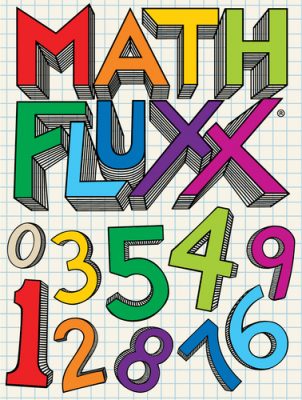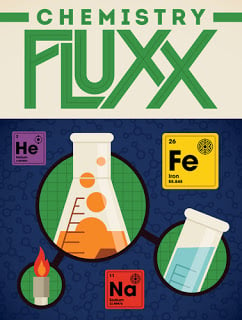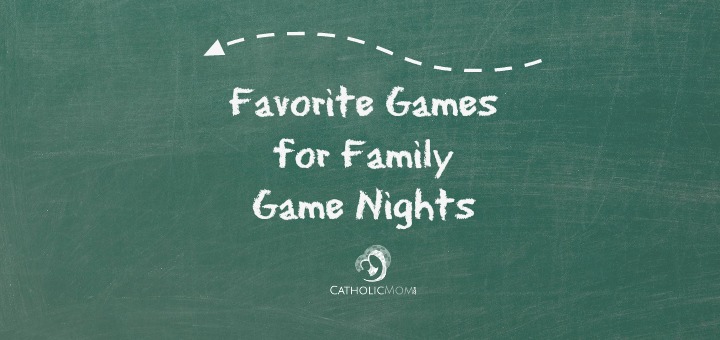I was introduced (unknowingly) to the world of modern board gaming by my wife's cousin, who is a priest for the Archdiocese of Memphis. He brought over the card game Fluxx, taught it to us, and the rest is history. Since then, I have bought and played many games, including different versions of Fluxx, and let me tell you . . . there are a bunch of them! Not only has the original game evolved with each new edition (currently on the 5th), but there are also different "flavors," such as holiday, pirate, zombie, Monty Python (hilarious), and my personal favorite Oz. Recently, they have opted for educational themes with their popular card game and introduced Math and Chemistry versions. Today, I will tell you about the Math and Chemistry versions of this card game. Math Fluxx is a game for 2 to 6 players, for grades 3 to 7. It takes between 5 and 40 minutes to play and retails for $16.

I love Fluxx, in all its variations, and Math Fluxx is no exception. Fans of the Fluxx line will see a lot that they recognize in this box, including 99% of the New Rules and Action cards. Some of the new New Rule cards incorporate the theme by use of Grafting, Addition, Multiplication, or some combination of Addition, Subtraction, Multiplication, and Division. The Meta Rules can also put some of these New Rules into effect permanently. All the Keepers in the game are numbers from 0 to 10 and this leads to the strongest use of the theme - the Goals. There are 29 Goal cards in the game, which range from basic (Today's Date or Your Own Age) to cleverly funny (101 Spotted Dogs or Numbers Be Hungry a.k.a. 7 8 9). There are even a few goal cards that you may get, but your kids won't, such as The Speed of a Long Playing Record (33), The Speed of Time Travel (88), and The Ultimate Answer (42). So consider this game not only a math lesson, but a culture lesson as well!
Those not familiar with Fluxx will find this game a blast to play, just because you never know when it's going to end. Some games will only last a few hands, just because of the way the game falls. Other games will be a slug-fest game of hoarding Keepers, denying your opponents Goals they need, and resetting the rules after you used the benefit, so no one else can use them. What's great about Math Fluxx is that it's not only fun to play, but it's going to teach your kids as well. The summer is quickly approaching, and you are going to want to keep your kids' brains active during the summer. This is a perfect game to do that. In addition to this being a fun game for the classroom, this game is also great for the homeschooling crowd. I especially love the background artwork on the cards that replaces a generic white with graph paper. It's a small thing, but makes it pop. With the simple game play and low price point, this game is very friendly for families on a budget.
[tweet "Fluxx games help keep kids' #math and #science skills sharp! Review by @StuartsStudy"]
 Chemistry Fluxx is what I would call the sister game of Math Fluxx, as they were introduced in the same year and with the same audience in mind. Like its sister game, Chemistry Fluxx plays 2 to 6 players, ages 8+. It can take 5 to 40 minutes to play and retails for $16.
Chemistry Fluxx is what I would call the sister game of Math Fluxx, as they were introduced in the same year and with the same audience in mind. Like its sister game, Chemistry Fluxx plays 2 to 6 players, ages 8+. It can take 5 to 40 minutes to play and retails for $16.
In addition to all the normal cards you get with Fluxx, Chemistry Fluxx adds some fun new Rules to the game, each with an appropriate science theme. There's "Spontaneous Reaction," which lets you take the top card from the draw pile and play it, and there's "Compound Effect," which lets you draw two cards if you can form a compound from the Keepers you have in front of you. However, the best new rule is "Helium Effect," which makes you talk in a high-pitched voice if you the Keeper Helium in front of you. It's torture for me, because of my deep voice, but it's hilarious for everyone else, so I guess that's a win for them?
The other cards different in this game from other Fluxx games are the Keepers and Goals. The Keepers are a mixture of chemistry equipment (beaker, test tube, Bunsen burner, etc.) and common elements (Hydrogen, Helium, Carbon, Oxygen, etc.). The Goals focus primarily on combining elements with a few of them focusing on the chemistry equipment. What's great about the ones that form compounds is that it teaches your kids the name of the compound, the elements that it is composed of, and is clever in the presentation. For example, NaCl is Sodium Chloride or Salt. H2S is Hydrogen Sulfide or "Smells like Rotten Eggs."
When I compare this game to Math Fluxx, I found myself enjoying this game a bit more. I think it's a combination of subject matter preference mixed with it feeling a bit more age-appropriate for myself. If I had to recommend which one to buy, I'd tell you to buy both, as they are both super-affordable and teach different subjects. If you had to force me to pick one, I'd say it depends on the age of your children. Math Fluxx is better for younger children, but Chemistry Fluxx would be more appropriate for middle-school to high-school ages. That said, I think your younger children would benefit from learning Chemistry basics at an early age, so again, I say, "Buy them both!"
Learn more about how to set up and play either game.
These games were provided to me for free by Looney Labs in exchange for an honest review.
See all the Favorite Games for Family Game Nights reviews here.
Copyright 2017 Stuart Dunn
About the Author

Stuart Dunn
Stuart Dunn was born and raised in Mobile, AL and received a Bachelor of Arts in Psychology and a Master of Business Administration from the University of South Alabama. Stuart reviews all things Catholic including adult books, children’s books, Bible Study series, Catholic Courses, CDs, and DVDs in addition to board games at his blog Stuart’s Study at StuartsStudy.blogspot.com.



.png?width=1806&height=731&name=CatholicMom_hcfm_logo1_pos_871c_2728c%20(002).png)
Comments